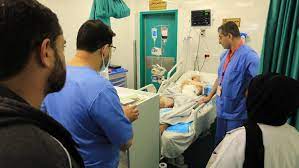A Parallel Battle for Daily Medical Needs Emerges in War Zones
A parallel tragedy takes place amid the frightening calls for aid and the loud boom of gunshots. While extremists terrorize innocent bystanders, a more subdued story of suffering is being told in another area of the war-torn region: the desperate fight for access to basic medical care.
Following hostilities that have broken out in many parts of the world, in which millions of people are killed in violent fights, a greater number of people suffer from unfulfilled medical demands.
Gaza
Healthcare workers are facing a difficult situation as Israel’s attack on Gaza continues. They must decide who to rescue while dealing with a staffing deficit and running out of supplies.
Patients from hospitals in Northern Gaza were evacuated and sent to the southern regions last week in reaction to the advance of Israeli soldiers into the area. Despite the fact that the European Hospital in southern Gaza was operational, a physician there told The Guardian that they were “being overwhelmed” by the volume of patients being in.
“There’s nowhere to flee to… There’s nowhere to run to. Surgeon Paul Ley remarked, “We are probably one of the last lines of defence.” He recounted the horrific events that occurred in the hospitals, including how many people had to sleep on elevators because there wasn’t enough room, and how others had to have their limbs amputated because they had infections that wouldn’t go away for long.
The shortage of vital drugs and interruptions in vital treatments like chemotherapy and dialysis are making cancer patients and those with chronic diseases worse and, in the worst situations, facing death.
In Gaza, thousands of women are putting their lives in danger to give birth, and thousands more are having emergency operations and caesarean sections performed without sterilization, anesthesia, or analgesics. The deaths toll from frequent power outages has increased because more people, especially newborns, have perished while using incubators and life support systems.
“The quantities of medical aid and fuel that arrived in the Gaza Strip, especially the northern areas of the strip, are very limited and insufficient, in light of the catastrophic health condition of the hospitals,” says Munir Al-Bursh, Director General of the Health Ministry in the Gaza Strip.
Bursh characterizes the situation as “extremely catastrophic and lacking the necessary health components,” with Gaza’s health system on the verge of collapse.
Ukraine
Leonard Rubenstein, a health and human rights specialist at Johns Hopkins University, claims that over 1100 strikes on Ukrainian hospitals have occurred in the previous 22 months. These attacks are a regular occurrence as Russian troops target them.
Three people were killed and eight injured when two missiles struck a hospital in Selydove, Ukraine’s Donetsk region, on November 20.
Since the conflict began, events have made it clear that a key component of Russia’s agenda is to dismantle the healthcare system, thus endangering the people of Ukraine’s right to health.
Lack of running water and power, among other insufficient infrastructure, is making it difficult to provide basic healthcare services in the war-torn Ukraine.
Patients in eastern Ukraine are forced to travel farther or forego treatment entirely since hospitals there are only able to provide a restricted level of service. The prevalence of routine vaccinations has drastically decreased, especially in youngsters, raising the danger of illnesses including diphtheria, measles, and polio.
Chronic illness treatment has grown more difficult, and the conflict has negatively impacted mental health, resulting in psychological stress in both troops and civilians.
Sudan
The current assessment from the United Nations Development Programme (UNDP) highlights that Sudan’s already “dire Human Development outlook” is further exacerbated by massive displacement, severe hunger, and the imminent danger of spreading illnesses.
Civilians in Sudan are living in abject circumstances as a result of the worsening conflict, and they are having difficulty obtaining necessities like food, water, and medication.
Around the nation, cholera outbreaks have been reported, and by December, 3.1 million people are thought to be at danger of developing acute watery diarrhea and cholera. Over 8,000 000 cases of malaria have been reported.
According to the World Health Organization, 80% of hospitals in Sudan’s conflict-affected regions had to close due to a lack of medical personnel and materials.
As to the WHO statement, “3.4 million children under the age of five, or one in every seven children, are acutely malnourished, with over 690 000 children severely malnourished. More than 42% of the entire country’s population has fallen into high levels of acute food insecurity.”
WHO also sent its “deepest concern” for the state of affairs in Darfur, the part of Sudan’s west most worst hit by the conflict. “We are increasing our cross-border aid from Chad into Darfur, and this week, WHO will be contributing $2.5 million of our own funds to keep these initiatives going.”
Syria
Syria’s infrastructure and health system have collapsed after more than ten years of fighting, leaving just a small number of hospitals that can provide thorough care. A cholera epidemic that began in September 2022 and expanded quickly in 2023 was caused by a lack of clean water and crowded living conditions.
The terrible earthquake that struck northern Syria in February 2023 has made access to medical treatment much more difficult and has exacerbated the country’s healthcare problem. With wounded people strewn over floors and corridors in many of the hospitals without the resources needed to manage an emergency of this magnitude, physicians felt helpless.
Women and children have been particularly impacted by the earthquake, with a decrease in their sexual and reproductive health and an increase in incidences of post-traumatic stress disorder (PTSD).
The earthquake caused hundreds of hospitals and health facilities to collapse or sustain significant damage, making it difficult for expectant mothers and new moms to get critical treatment, such as emergency obstetric assistance and cesarean sections.







